Vaginal douching and health risks among young women
Abstract
Objective
Vaginal douching is practiced by women for various reasons. Studies have shown that this practice can upset the normal vaginal flora, increasing susceptibility to certain sexually transmitted diseases (STIs). This study aimed to assess the health risks associated with this practice among women aged 15–54 years in a densely populated community in Kumasi, the second capital city of Ghana.
Methods
A cross-sectional survey was conducted to gather data on the prevalence of vaginal douching among young women and their beliefs, motivations, and knowledge about the practice. A structured questionnaire was used in recruiting participants. One-hundred and fifteen structured questionnaires were administered to women aged between 15 and 54 after their consent was sought.
Results
The study established that more than half of the participants (69.6%) engaged in douching with a midpoint of 19.5. The study indicated no significant difference between the age of participants and douching (p < 0.93). However, there was an indication of a significant association between educational status, marital status, and perception in relation to douching (p < 0.003, 0.0015, and 0.00, respectively), which also influenced the frequency of douching and contraction of STIs.
Conclusion
Most women in the study community recruited, regardless of their educational and marital status, believed that douching is necessary and considered part of feminine hygiene practices. Practicing douching may lead to most health complications including pelvic inflammatory disease and infertility which must be given serious attention by researchers, health personnel, and various women's groups.
1 INTRODUCTION
Vaginal douching is the process of intravaginal cleansing with a liquid solution and other substances.1 These substances used are mostly from herbal concoctions, commercial preparations as well as home remedies using baking soda or vinegar and spices like ginger, salt, lime, or lemon among others.2 Although douching has been in practice since 3000 years ago,3 it however, gained much popularity and became common in 1902, after Greer stated that, “every part of the body should be clean as the face” in the book of female hygiene.4 Owing to the popular adage in Africa, “Cleanliness is next to Godliness” and some other cultural beliefs, it is not surprising to find douching behavior more prevalent among blacks of African descent.5
Although vaginal douching is a common practice among women with different cultural traits, the reason for douching remains the same.6 These include to; clean menstrual blood, feel clean and fresh, prevent pregnancy, eradicate itching, or tighten the vagina. Alleviating vaginal discharges and odor, and sexual pleasure have also been reported.6 Presently, the alarming increase in vaginal douching among women can be attributed to advertisements by the manufacturers of such douching products. These products are sold in almost all pharmacies and grocery stores thereby making them readily available to women who are desperate and in need of a feminine hygiene product.7 A larger percentage of women across different racial and ethnic backgrounds engage in vaginal douching, with most of these women being black (55%). Dodson et al.,8 found that women with an educational background below high school level (53%) are more likely to engage in vaginal douching. Although its prevalence has declined, douching remains high among the most vulnerable women mentioned above. Despite the numerous reasons provided by these vulnerable women to justify their practice of vaginal douching, they are often unaware of the adverse health implications associated with it. Studies have shown a link between Vaginal douching and several adverse health outcomes which include but not limited to pelvic inflammatory disease (PID), bacterial vaginosis, cervical cancer, human immunodeficiency virus transmission, sexually transmitted diseases (STIs), low birth weight, preterm birth, ectopic pregnancy, recurrent Vulvovaginal candidiasis, and infertility.6 This is because douching alters the normal vaginal pH and vaginal flora, weakening the vagina's natural defenses and creating an environment more susceptible to the overgrowth of pathogens enhancing individual susceptibility to certain sexually transmitted infections.9 For instance, women who douche have a higher risk of contracting bacterial vaginosis and in their attempt to treat the symptoms of bacterial vaginosis through douching,10 the healthy bacteria end up being killed while the unhealthy bacteria are allowed to grow. In pregnant women, chronic bacterial colonization of the endometrium due to douching may arise which may cause premature rupture of the uterine membrane resulting in early labor.11
Contrary opinions among other studies with respect to the causal link or an observed association between douching and adverse health outcomes have been discussed widely.12 Women with certain risk factors (multiple sex partners, poverty, certain races, and low educational levels) are at the greater risk of acquiring sexually transmitted infections, bacterial vaginosis, and PID.13 In this wise, whether infections are in fact directly connected to douching or not is yet to be known. The immediate connection between douching and reproductive tract infections brings forth health concerns because some products used in antiseptic douching contain toxins or antimicrobial agents that are inhibitory to lactobacilli. These lactobacilli are the major bacteria in a normal, healthy vagina14 and are found in decreased levels among women with bacterial vaginosis. Vaginal douching has been prevalent among women for centuries. However, there is growing concern about the potential health risks associated with this practice, particularly among young women.
The objective of this study was to evaluate the health risks associated with vaginal douching in a densely populated community in Kumasi, which serves as the second capital city of Ghana. This research aimed to address the existing data gap on this topic and provide valuable information to educate women, families, policymakers, and implementers about the health risks associated with douching.
2 MATERIALS AND METHODS
2.1 Study design
The study was conducted in a central densely populated community in Kumasi in the Ashanti region of Ghana. A cross-sectional survey was conducted to gather data on the prevalence of vaginal douching among young women and their beliefs, motivations, and knowledge about the practice. This phase helped establish the baseline information necessary for subsequent phases. The second phase was the constructive phase which involved using findings from phase 1 to construct and test cognitive behavioral intervention (women's intention to douche and the actual frequency of douching); the third and final phases were the implementation and evaluation of the intervention.
2.2 Sample collection
A representative sample of women within the community was selected using a random sampling technique to ensure the generalizability of the findings. Using a prevalence of 67.7%.15 One hundred and fifteen structured questionnaires addressing douching practices, frequency, duration, reasons for douching, knowledge about associated health risks, and demographic information were administered by trained interviewers to the women who were either literate or illiterate aged between 15 and 54. Women employed in corporate settings or office environments were not included in the study and were excluded from the sample. To ensure privacy and encourage honest responses, a suitable venue was arranged, in a private room within a health facility. Each participant in the study was provided with a clear explanation of the study's purpose. Questionnaires were then administered to those who gave their consent to participate. In cases where participants faced challenges with writing, assistance was provided to ensure their participation in the study.
2.3 Ethical considerations
The study received approval from the Institute of Research Innovation and Development of Kumasi Technical University (IRID) (ref no: IRID/EC2023/HS0039). Questionnaires were then administered to those who gave their consent to participate, ensuring that their anonymity and confidentiality were protected. Participants were also provided with information about the potential risks of vaginal douching and offered appropriate counseling or referral services if needed.
2.4 Data analysis
Questionnaires administered were evaluated for accuracy in number and entry. The collected data was entered into Microsoft 365 Excel datasheet, version 2019, and imported to IBM Statistical Package for Social Sciences software version 20 for analysis. Descriptive statistics were used to determine the prevalence of vaginal douching within the community. Associations between douching practices and health risks were explored using chi-square or logistic regression analysis.
3 RESULTS
3.1 Demography of participants
Out of the 115 questionnaires that were given, 80 women (69.6%) stated that they engage in douching, while 35 women said they do not. Among these women, 40% had an average age of 19.5 years, while 7% had an average age of 49.5 years. The majority of women in the study were well-educated. In terms of marital status, most of them were married, as shown in Table 1.
| Category | Variable | Douching | p Value | |
|---|---|---|---|---|
| Yes | No | |||
| Average age (years) | 19.5 | 32 (43) | 15 (43) | 0.93 |
| 29.5 | 28 (31) | 13 (37) | ||
| 39.5 | 13 (16) | 5 (14) | ||
| 49.5 | 7 (10) | 2 (6) | ||
| Educational background | Illiterate | 4 (6) | 2 (6) | 0.003 |
| Junior high school | 14 (24) | 4 (11) | ||
| Senior high school | 24 (30) | 23 (66) | ||
| Tertiary | 33 (40) | 6 (17) | ||
| Marital status | Single | 29 (35) | 10 (29) | 0.015 |
| Married | 25 (32) | 10 (29) | ||
| Divorce | 2 (3) | 7 (20) | ||
| In relationship | 24 (30) | 8 (22) | ||
| Knowledge of the dangers of douching | Yes | 23 (29) | 29 (83) | 0.00 |
| No | 57 (71) | 6 (17) | ||
3.2 Reasons for douching among study participants
Several reasons for douching were reported by the participants:
Good and Fresh Feeling: Approximately 35% of the study participants stated that they engage in douching to achieve a sense of cleanliness and freshness.
Pregnancy Prevention: A total of 6% of the participants reported using douching as a method to prevent pregnancy.
Other Reasons: Interestingly, 10% of the participants mentioned douching for various reasons beyond those specifically stated in the questionnaire. This study has established that, 35% of the study participants douche to have good and fresh feeling, 6% engage in douching to prevent pregnancy, and 10% of the participants also indicated that they douche for variable reasons other than the ones stated in the questionnaire (Figure 1).
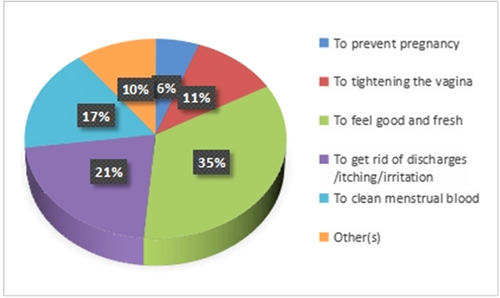
3.3 Methods used for vaginal cleaning among respondents
The study findings revealed various methods employed by the respondents for cleaning their vagina either before or after bathing. The distribution of these methods is presented in Figure 2 and can be summarized as follows:
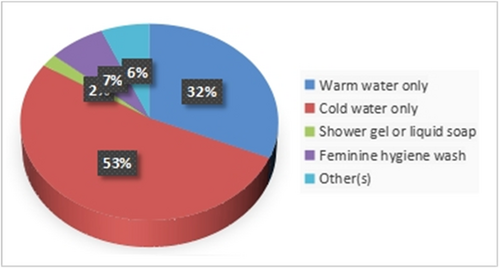
Cold Water: Most of the respondents, accounting for 53%, reported using cold water for vaginal cleaning.
Shower Gel/Liquid Soap: Only a small proportion, comprising 2% of the respondents, utilized shower gel or liquid soap for vaginal cleaning.
Warm Water: Approximately one third of the respondents, around 32%, indicated the use of warm water in their vaginal cleaning routine.
Feminine Hygiene Wash: A notable 7% of the respondents reported using feminine hygiene wash for their vaginal cleaning. Other Substances: Six percent of the respondents employed alternative substances for vaginal cleaning, which were not explicitly specified in the study.
3.4 Indication of douching frequency
The chart in Figure 3 illustrates the douching frequency reported by the study participants. Most participants, comprising 23 individuals, reported douching on a daily basis. In contrast, a smaller group among the participants, consisting of 10 individuals, indicated douching once a month.
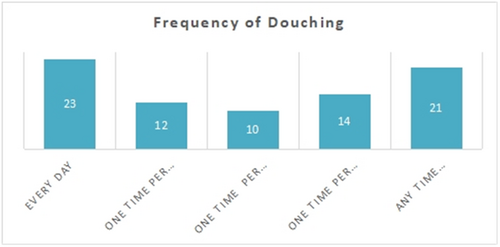
3.5 Prevalence of infections among participants engaged in vaginal douching
Among the 115 participants included in the study, 41% of those who performed vaginal douching were found to have contracted Bacterial vaginosis. Furthermore, a small percentage of 5% were identified as having contracted Gonococcal infection.
Figure 4 presents additional information regarding the prevalence of different types of infections among the participants.
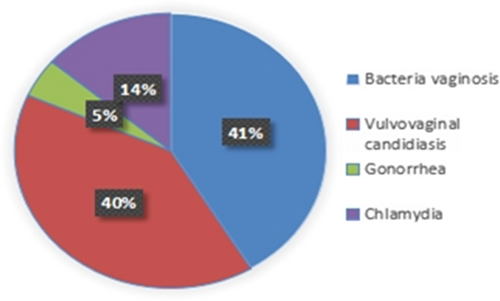
3.6 Prevalence of PID, preterm birth, and ectopic pregnancy among participants
This study has found that the prevalence of PID among the participants was 73%. Additionally, 16% of the participants reported a history of preterm birth, while 11% had experienced ectopic pregnancy (Figure 5).
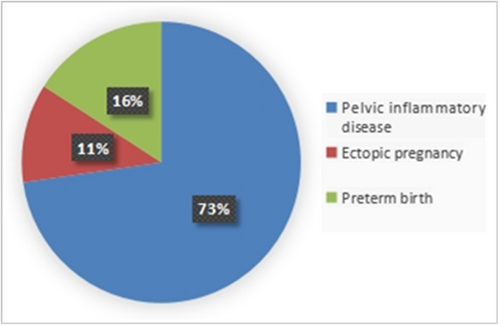
4 DISCUSSION
4.1 Rate of vaginal douching
Vaginal douching has been in practice over centuries by most women, regardless of their class or status.3 Douching has been well embraced by the majority of black women of African descent amidst its health impact.5 The purpose of this study was to gather accurate and comprehensive data on the prevalence of a longstanding, neglected practice in a densely populated community in Kumasi, Ghana. By conducting the study in this specific location, we aimed to gather valuable insights and generate a well-informed report on the current state of this practice. The findings of this study provide important insights into the prevalence of vaginal douching and its association with the rate of infections among the participants. The results reveal that a significant proportion of participants (69.6%) reported engaging in douching. This high prevalence suggests that vaginal douching is common among the study population.
The high rate of douching raises concerns as it has been associated with an increased risk of infections.16-18 The study findings support this notion, with a substantial percentage of participants (41%) who reported contracting bacterial vaginosis as a consequence of douching. Bacterial vaginosis is a common vaginal infection characterized by an imbalance in the vaginal flora. Douching can disrupt the natural balance of bacteria in the vagina, leading to an overgrowth of harmful bacteria and increasing the risk of Bacterial vaginosis.19 In addition to Bacterial vaginosis, a smaller percentage of participants (5%) reported contracting Gonococcal infection, which is a sexually transmitted infection. While the direct causal relationship between douching and Gonococcal infection may require further investigation, it is plausible that douching practices may contribute to an increased vulnerability to sexually transmitted infections due to the disruption of the vaginal environment. The study's findings underscore the need for awareness and education regarding the potential risks associated with vaginal douching.
To address the prevalence of douching and the associated rate of infections, healthcare providers play a critical role in counseling and educating patients. Open and non-judgmental discussions can help individuals understand the potential harms of douching and provide alternatives for maintaining vaginal health. Emphasizing the importance of maintaining a balanced vaginal microbiome through healthy lifestyle habits, such as practicing safe sex, wearing breathable underwear, and avoiding harsh hygiene products, can contribute to reducing the incidence of infections related to douching.
The findings of the current study revealed that women between the ages of 15 and 24, who are typically students in various educational levels such as basic school, high school, or tertiary institutions, were found to be engaged in douching. This age group represents a stage of exploration and self-discovery, which may contribute to their involvement in this practice.
Interestingly, a previous study conducted in 2019 in the Northern part of Ghana reported a slightly lower prevalence of douching (66.5%) compared to the current study's findings.15 This suggests that douching practices may vary among different regions or populations within Ghana. This may be attributed to the reason that the cultural settings are different and the availability of substances for douching is not similar. Again, a prevalence of 46% was established in the Southern United States in a similar study conducted among black women.20 This could be attributed to the fact that a good number of women elites are found in the United States, enhanced education, and restrictions on the sale of substances used for douching. However, this present study indicated a prevalence comparable to studies conducted in most parts of Africa, such as Nigeria, 80% among adult females,21 84% and 72% among sex workers in Dar es Salaam, Tanzania and among women attending reproductive health clinics, respectively.22 According to Bui et al.,23 Obviously, women who engage in sex work encounter multiple sex partners and claim that from time to time, they insert substances to either tighten the vagina or keep it clean and fresh so as to attract more clients.23 This current study agrees with previous studies conducted in other countries and establishes the fact that, douching is a common practice among women even with different cultural traits, social classes, and backgrounds.24 However, there are variations in the prevalence of douching from one population setting to the other,25 probably due to the fact that mindsets, cultural education, and restrictions on the sale of medicines, contraceptives, and other related products and concoctions differ from population to population.26
4.2 Effect of vaginal douching on age and educational status
This study established no effect or impact of age on females partaking in douching activities (p value = 0.93). However, there is a significant effect of educational status on vaginal douching among the participants (p < 0.003). The findings reveal that a majority of the women who engaged in douching were found to be in school, ranging from basic school to high school and tertiary institutions. This observation suggests that educational status may play a role in shaping douching behaviors. Women who are in school, particularly in the exploration stage of their lives, may be more susceptible to adopting certain practices, including vaginal douching. It is possible that factors such as peer influence, limited knowledge about reproductive health, or misconceptions about hygiene and cleanliness contribute to the higher prevalence of douching among this group. These findings align with previous research,21 indicating a potential association between educational status and reproductive health behaviors. Moyle27 and Hionidou28 attribute this to the influence of advertisements made in the English language. Education can significantly influence individuals' knowledge, attitudes, and practices regarding sexual and reproductive health. It is crucial to recognize the impact of education in shaping behaviors and to leverage educational settings as platforms for comprehensive reproductive health education.
4.3 Vaginal douching and marital status
This study revealed a noteworthy association (p value = 0.015) between marital status and the practice of vaginal douching.
One significant finding is that a considerable proportion of participants (35%) reported engaging in douching to achieve a perceived sense of cleanliness and freshness. This finding aligns with previous research indicating that individuals often view douching as a hygiene practice to maintain vaginal cleanliness.29, 30 However, it is important to note that the vagina is self-cleaning and has its own natural mechanisms to maintain a healthy balance of bacteria and pH. Regular douching can disrupt this delicate balance and potentially lead to adverse outcomes, including an increased risk of infections and other complications.
4.4 Knowledge and perception of vaginal douching
This study indicated that the practice of vaginal douching is greatly impacted by the Knowledge and perception of the health effect of douching by females engaged in douching practices (p = 0.00). This conforms with reports from previous studies.31, 32 People and countries hold diverse perceptions regarding the practice of vaginal douching. Some hold the belief that vaginal douching is employed for personal hygiene or esthetic purposes.33, 34
Another noteworthy finding is that a subset of participants (6%) reported using douching as a method of contraception to prevent pregnancy. It is essential to clarify that douching is not an effective method of birth control. Relying on douching for contraception can result in unintended pregnancies and may expose individuals to additional risks associated with ineffective contraception.
The study also highlighted that a significant number of participants (10%) reported douching for other reasons not mentioned in the questionnaire. These diverse motivations suggest a need for further exploration into the factors driving this practice. It is crucial to address the misconceptions surrounding douching and provide comprehensive education on its potential risks.
Regarding the methods used for douching, the findings indicate that a majority of participants (53%) utilized cold water for this practice. This preference for cold water may be influenced by cultural beliefs or personal preferences. However, it is important to note that the temperature of the water used for douching is not a determinant of its safety or efficacy. The focus should instead be on promoting evidence-based reproductive health practices and discouraging routine douching altogether.
Additionally, a small percentage of participants (2%) reported using shower gel or liquid soap for douching. This is concerning as these products are not formulated for vaginal use and can disrupt the natural vaginal flora, leading to irritation, inflammation, and increased susceptibility to infections.
The results of this study shed light on the prevalence of various reproductive health conditions among participants who engage in vaginal douching. The high incidence of PID among the participants (73%) is noteworthy, as it suggests a potential association between vaginal douching and the development of PID. Vaginal douching involves the rinsing or cleaning of the vaginal area with various substances, which may disrupt the natural balance of bacteria and increase the risk of infections such as PID.19, 35 The findings underscore the importance of caution and informed decision-making when considering vaginal douching practices.
Furthermore, the study revealed a significant proportion of participants reporting preterm birth (16%) and ectopic pregnancy (11%). While the direct link between vaginal douching and these specific outcomes may not be established in this study, it highlights the need for further investigation into potential associations between douching practices and adverse pregnancy outcomes. Vaginal douching has been linked to alterations in the vaginal microbiome and increased susceptibility to infections, which in turn may impact pregnancy outcomes.35 The findings warrant heightened awareness among healthcare providers and individuals regarding the potential risks associated with vaginal douching during pregnancy.
It is important to consider that vaginal douching is a practice that has been debated in terms of its benefits and risks. Some individuals may engage in douching for perceived cleanliness, freshness, or other reasons. However, the study findings suggest that vaginal douching may be associated with a higher prevalence of PID and potentially adverse pregnancy outcomes. This highlights the need for comprehensive education and awareness campaigns to promote evidence-based practices and discourage the routine use of vaginal douching.
4.5 Implications
This section outlines the practical implications of the study's findings for various stakeholders, with a focus on mental health, education, and research.
4.5.1 Mental health services
The research underscores the need for increased awareness and mental health support for young women who may engage in potentially risky behaviors such as vaginal douching. Mental health services should address the emotional and psychological aspects related to this practice, aiming to reduce stigma and offer counseling and guidance.
4.5.2 Education programs
Educational institutions should consider incorporating comprehensive sexual and reproductive health education into their curriculum. This should include discussions about vaginal douching, its potential risks, and safe alternatives. Such programs can empower young women with knowledge to make informed decisions about their reproductive health.
4.5.3 Future research directions
Future research should focus on longitudinal studies to establish causality between vaginal douching and health risks. Additionally, investigating the effectiveness of interventions, such as educational campaigns and peer support networks, is warranted. This will contribute to evidence-based strategies for reducing the prevalence of douching and its associated health risks.
5 CONCLUSION
In conclusion, this study has provided a comprehensive information on vaginal douching and its health risks among young women. The findings emphasize the urgent need for further research and the implementation of targeted public health initiatives to address the risks associated with this practice.
The study revealed that vaginal douching is prevalent among young women, with a disproportionate number of black women and those with lower educational attainment engaging in this practice. Despite the numerous reasons given by these women to justify douching, they often remain unaware of the adverse health implications associated with it.
5.1 Limitations of the study
This section discusses the various limitations inherent in the research methodology and data collection process, which may influence the interpretation and generalizability of the study's findings.
5.1.1 Sampling bias
One notable limitation of this study is the potential for sampling bias. The participants were recruited from a specific demographic and geographic area, which may not be fully representative of the broader population of young women. This could limit the generalizability of the findings to a wider context.
5.1.2 Self-reported data
Another important consideration is the reliance on self-reported data. The use of self-reported information to gather data on vaginal douching practices and health outcomes may introduce recall bias and social desirability bias. Participants might not provide entirely accurate or complete information due to concerns about social stigma or societal expectations.
5.1.3 Causality and correlation
Establishing a direct causal link between vaginal douching and specific health risks can be challenging. While this study can identify associations, it may not conclusively demonstrate that douching directly causes particular health issues due to the presence of confounding variables and ethical constraints associated with conducting experimental studies.
5.1.4 Temporal factors
This research primarily adopts a cross-sectional design, which may limit its ability to fully understand the long-term health implications of vaginal douching. A longitudinal approach might be necessary to examine causality and the progression of health risks over time.
5.1.5 Social desirability bias
Given the sensitive nature of the topic, participants may not provide completely candid responses regarding their douching practices or experiences, which may affect the accuracy and completeness of the data.
5.1.6 Limited generalizability
The findings of this study may not be universally applicable, as cultural, regional, and socioeconomic differences can significantly impact the practice of vaginal douching and its associated health risks.
5.1.7 Lack of direct observation
The inability to directly observe douching practices is a limitation of this study. The researchers relied on participants' self-reports, which may affect the accuracy of data regarding the frequency and methods of douching.
5.1.8 Confounding variables
This study must contend with the presence of various confounding variables, such as sexual activity, contraceptive methods, and access to healthcare, which may influence the relationship between douching and health outcomes. Controlling for these variables can be a challenging endeavor.
These limitations should be considered when interpreting the results and drawing conclusions from this study on vaginal douching and its associated health risks among young women.
6 RECOMMENDATION
A longitudinal city-wide study should be conducted where data will be used by policymakers, managers, and implementers to structure programs for thorough education and law enforcement on habit of sale of certain substances.
AUTHOR CONTRIBUTIONS
Solomon Wireko: Conceptualization; data curation; formal analysis; funding acquisition; investigation; methodology; project administration; resources; validation; writing—original draft; writing—review and editing. Mina Ofosu: Conceptualization; data curation; formal analysis; funding acquisition; investigation; methodology; project administration; resources; supervision; validation; writing—review and editing. Florence Agyemang: Data curation; formal analysis; methodology; software; validation; visualization; writing—original draft; writing—review and editing. Herbert Ekoe Dankluvi: Data curation; formal analysis; investigation; methodology; resources; software; visualization; writing—original draft; writing—review and editing. Andrews Evans Cobbina: Data curation; formal analysis; investigation; methodology; software; validation; visualization; writing—original draft; writing—review and editing.
CONFLICT OF INTEREST STATEMENT
The authors declare no conflict of interest.
TRANSPARENCY STATEMENT
The lead author Solomon Wireko affirms that this manuscript is an honest, accurate, and transparent account of the study being reported; that no important aspects of the study have been omitted; and that any discrepancies from the study as planned (and, if relevant, registered) have been explained.
Open Research
DATA AVAILABILITY STATEMENT
The data sets used and/or analyzed during the current study are available from the corresponding author on reasonable request.




